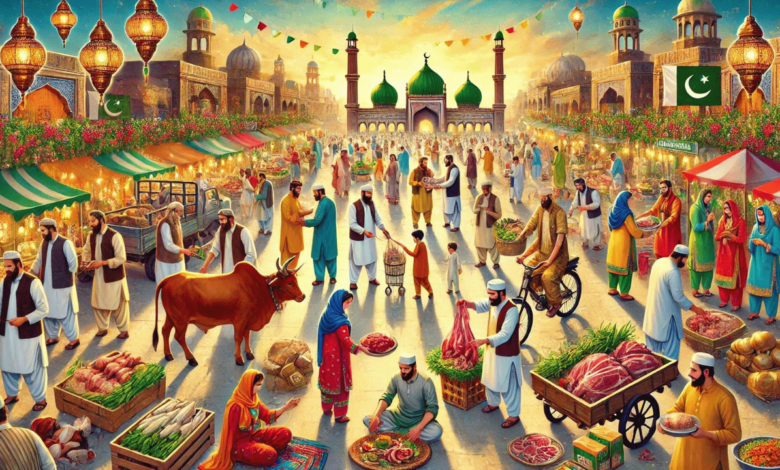Celebrating a Eid ul Adha 2023 Kamyab Pakistani Festival

Eid ul Adha, also known as the “Festival of Sacrifice,” is one of the most significant Islamic holidays celebrated worldwide. The festival holds profound cultural and religious importance in Pakistan, embodying the spirit of sacrifice, community, and prosperity. The theme for Eid ul Adha 2023 Kamyab Pakistani emphasizes the nation’s aspirations for success, economic growth, and social welfare. This article delves into the various facets of Eid ul Adha 2023 in Pakistan, highlighting its cultural traditions, community spirit, economic impact, and modern challenges.
The Essence of Eid ul Adha
Eid ul Adha commemorates the willingness of Prophet Ibrahim (Abraham) to sacrifice his son Isma’il (Ishmael) to obey Allah. Allah replaced Isma’il with a ram to be sacrificed instead as a testament to his faith. This story is central to the festival, symbolizing faith, devotion, and the importance of sacrifice in the Islamic tradition.
Cultural and Religious Traditions
Eid ul Adha is marked by various rituals and traditions that hold deep cultural and religious significance:
- Qurbani (Sacrifice):
- The primary ritual of Eid ul Adha is the Qurbani, where Muslims sacrifice an animal such as a goat, sheep, cow, or camel. The meat is distributed among family, friends, and the less fortunate, ensuring everyone can partake in the festivities.
- The act of Qurbani symbolizes obedience to Allah and the willingness to give up something valuable in devotion to God.
- Morning Prayers:
- The day begins with special prayers at mosques or open grounds, where Muslims gather in large numbers to seek blessings and forgiveness.
- These communal prayers foster a sense of unity and brotherhood among the attendees.
- Family Gatherings and Feasts:
- Eid ul Adha is a time for families to unite, share meals, and strengthen bonds. Traditional dishes like biryani, kebabs, and sweets are prepared, making the feast a central part of the celebration.
Community and Charity
Charity and community spirit are integral to Eid ul Adha, reflecting the values of compassion and social responsibility in Islam:
- Meat Distribution:
- One-third of the sacrificial meat is distributed to the less fortunate, ensuring that everyone can enjoy the festivalregardless of socio-economic status.
- This act of sharing fosters a sense of community and empathy.
- Charitable Activities:
- Various charitable organizations and individuals distribute food packages, financial aid, and clothing to low-income families. These initiatives help uplift people in need and bring joy to their Eid celebrations.
- Many community centres and mosques organize volunteer projects, providing opportunities for community service and outreach programs.
Economic and Social Impact
Eid ul Adha significantly impacts Pakistan’s economy, particularly in the livestock sector:
- Livestock Market:
- The demand for sacrificial animals surges during Eid ul Adha, creating a bustling market environment. Farmers and traders from rural areas bring their animals to cities, generating substantial economic activity.
- This seasonal boost supports countless families financially and contributes to the local economy.
- Government Initiatives:
- Under the “Kamyab Pakistan” program, the government has launched several initiatives to enhance economic opportunities and social welfare. These include financial assistance programs, skill development initiatives, and educational support to foster a prosperous society.
- The “Kamyab Pakistani” theme for Eid ul Adha 2023 underscores the importance of sustainable economic practices and the efficient use of resources to maximize benefits for all stakeholders.
Celebrations Amidst Modern Challenges
The COVID-19 pandemic has introduced new challenges to traditional celebrations, necessitating adaptations to ensure safety:
- Safety Measures:
- To protect against the spread of COVID-19, safety measures such as wearing masks, practising social distancing, and avoiding large gatherings have become essential.
- Many celebrations have shifted to virtual platforms, allowing families to connect and celebrate online while adhering to health guidelines.
- Virtual Celebrations:
- Virtual gatherings and online outreach have provided alternative ways to maintain the festive spirit. These adaptations ensure that the essence of Eid ul Adha is preserved despite the ongoing pandemic.
Cultural Preservation
Eid ul Adha is also a time to celebrate and preserve Pakistani culture and traditions:
- Traditional Attire:
- People wear traditional clothing such as shalwar kameez for men and colourful dresses for women. These garments showcase Pakistan’s rich cultural heritage and add to the festive atmosphere.
- Cultural Events:
- Community centres and organizations host events such as qawwali nights, traditional music performances, and cultural shows, enhancing the celebratory mood.
- Folk dances, music, and traditional games are integral to the festivities, keeping the cultural essence alive.
Reflecting on Spirituality
Eid ul Adha is a time for spiritual reflection and gratitude:
- Lessons of Sacrifice and Obedience:
- The story of Prophet Ibrahim’s sacrifice is a powerful reminder of Islam’s importance of faith, obedience, and selflessness.
- Muslims are encouraged to reflect on these values and express gratitude for Allah’s blessings.
- Gratitude and Humility:
- The festival fosters a sense of humility and gratitude, urging Muslims to prioritize spiritual values over worldly desires.
Conclusion
Eid ul Adha 2023 Kamyab Pakistani, celebrated as embodies the spirit of sacrifice, community, and prosperity. It is a time to uphold traditions, reflect on spiritual values, and engage in charitable activities that uplift the less fortunate. Despite the challenges posed by the COVID-19 pandemic, the festival inspires unity, compassion, and economic growth. As Pakistanis come together to celebrate this auspicious occasion, they reaffirm their commitment to the values of sacrifice, charity, and social responsibility, making Eid ul Adha a truly memorable and meaningful festival.
You May Also Read: Exploring Mamgatoto: A Cultural Phenomenon with Deep Roots and Modern Relevance




